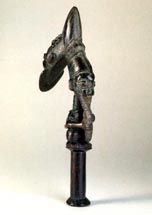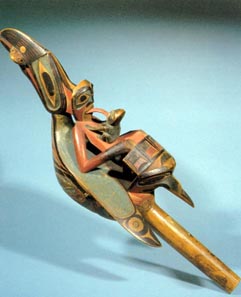Spirits
Take Form: Small Scale Sculpture from Three Culture Areas |
||
 |
 |
|
| Nigeria, NE (Ekiti) Yoruba. Dance staff/hook for Eshu Elegba. Wood. 19th C. Height: 42.9 cm. The University of Iowa, Museum of Art: The Stanley Collection. (Picture source: Drewal, Pemberton & Abiodun, fig.24). Eshu Elegba is an omnipresent deity in Yoruba culture who mediates between the spiritual and human worlds. The additional face on the back of the elongated headpiece, represents this role. The projecting headdress characterizes all Eshu sculpture and indicates "ase." All individuals have their own "ase" as well as their own Eshu looking after them. Eshu facilitates relationships if appropriately honored, and does the opposite if ignored. The sensuality and egocentism of Eshu are also alluded to by his headdress. |
Queen Charlotte Islands, Canada, Tlingit culture. Shaman's raven rattle. Wood. Late 19th/early 20th
C. Height: 31 cm. (Picture
source:Furst&Furst, pl.115). This shaman's rattle takes the shape of a raven, supporting a transformation scene between a shaman and a toad. Given its dramatic change from a water to a land creature during its life cycle, the toad proves to be an especially potent symbol for the shaman as a spiritual being. |
Irian-Jaya, Indonesia, Asmat culture. Ancestral Carving. Wood, lime, red ocher,
charcoal, sago leaf, bamboo. Late 19th/ early 20th C. Height: 40.5 cm. (Picture source:Smidt p.92) This commemorative ancestral figure displays both human and insect characteristics and takes the posture of a praying mantis, the Asmat symbol for head- hunting. The praying mantis posture also evokes the Asmat creation myth in which wooden people, after having their knees and elbows detached, were brought to life as the first human beings. |
| The Costume Connection | Impact of European Culture | Art of Music |
| The Container As Woman | The Wealth and Status Connection | Connections through Architecture |
| Home | Comments on Spirits Take Form | General Comments |